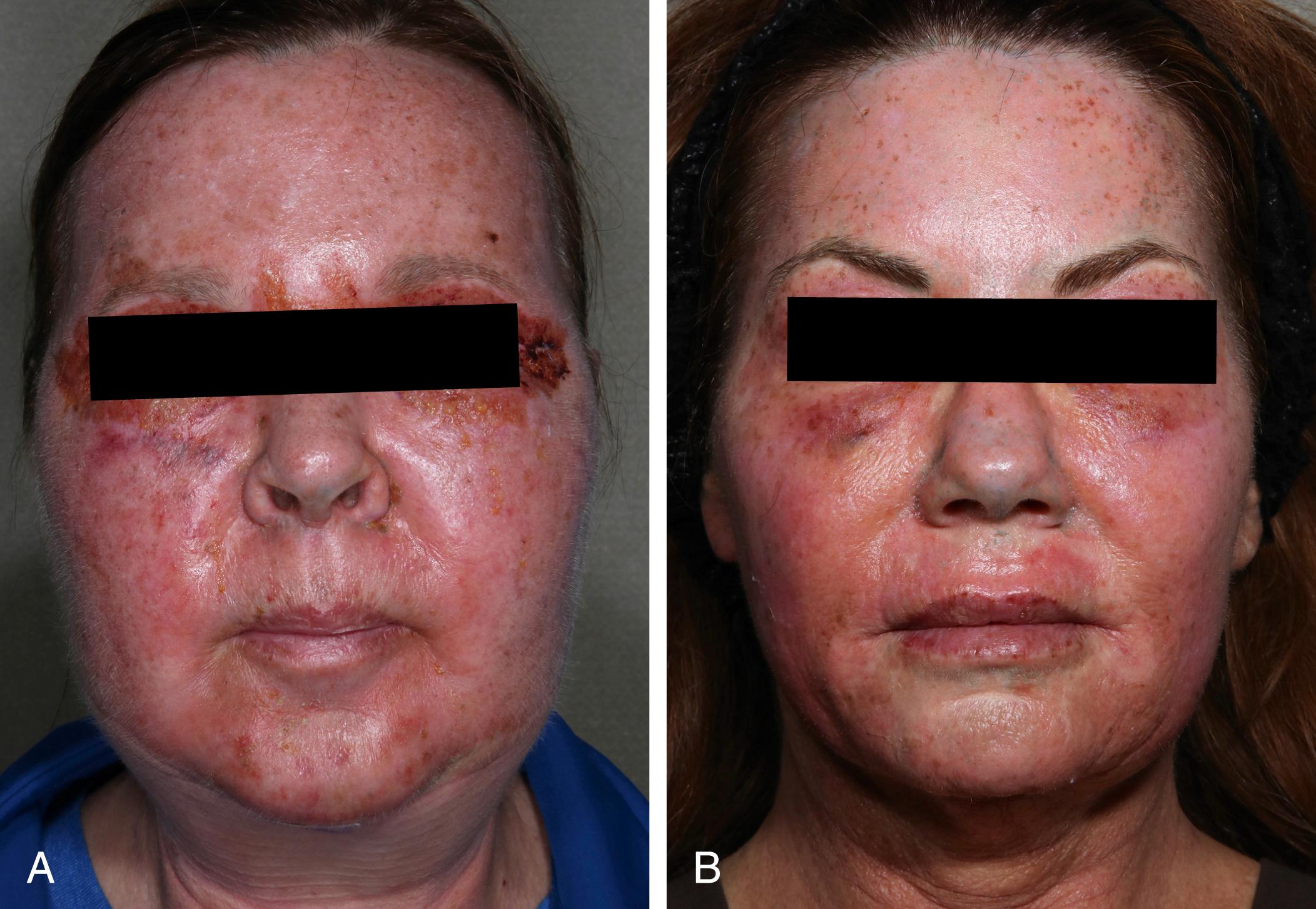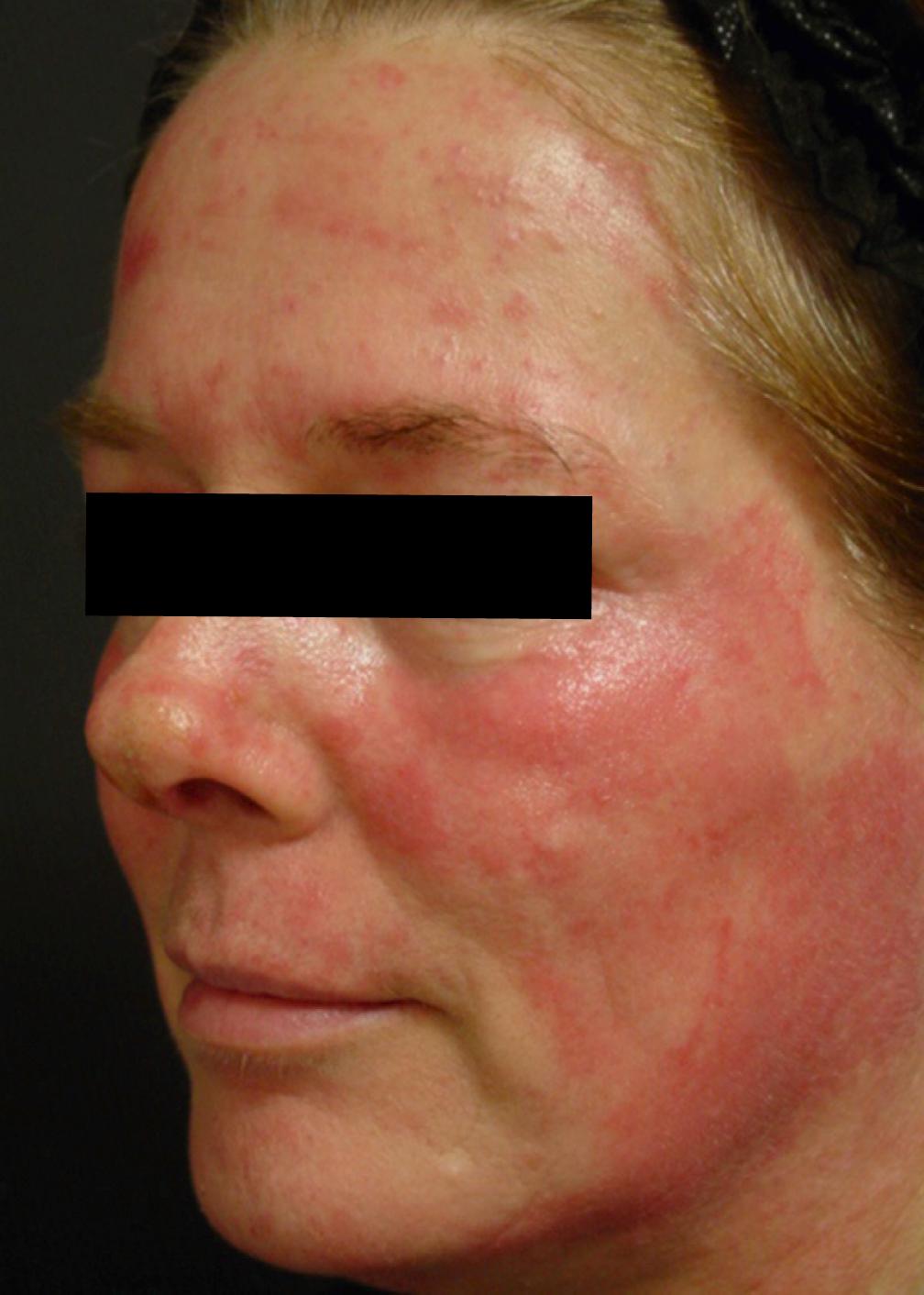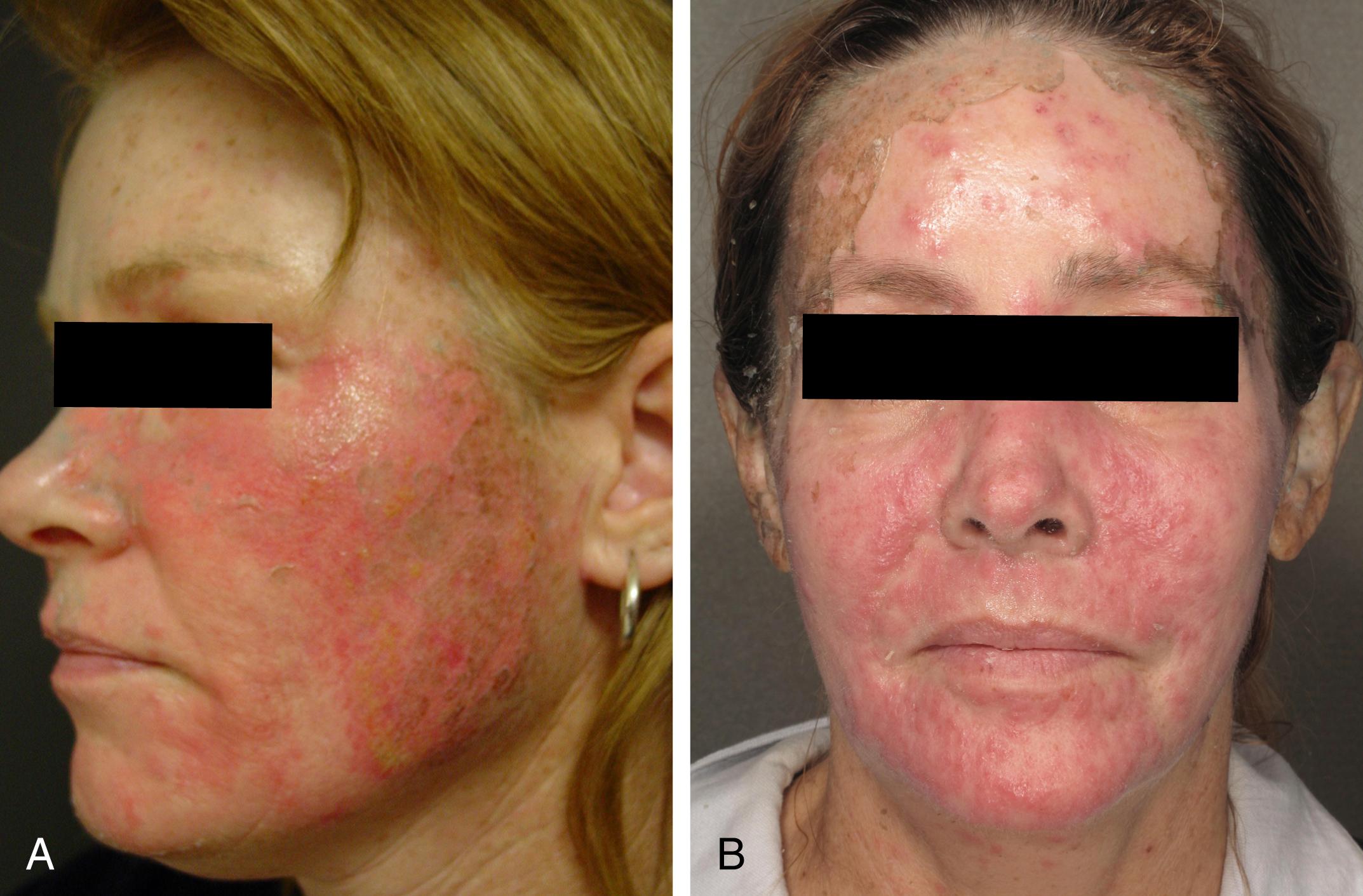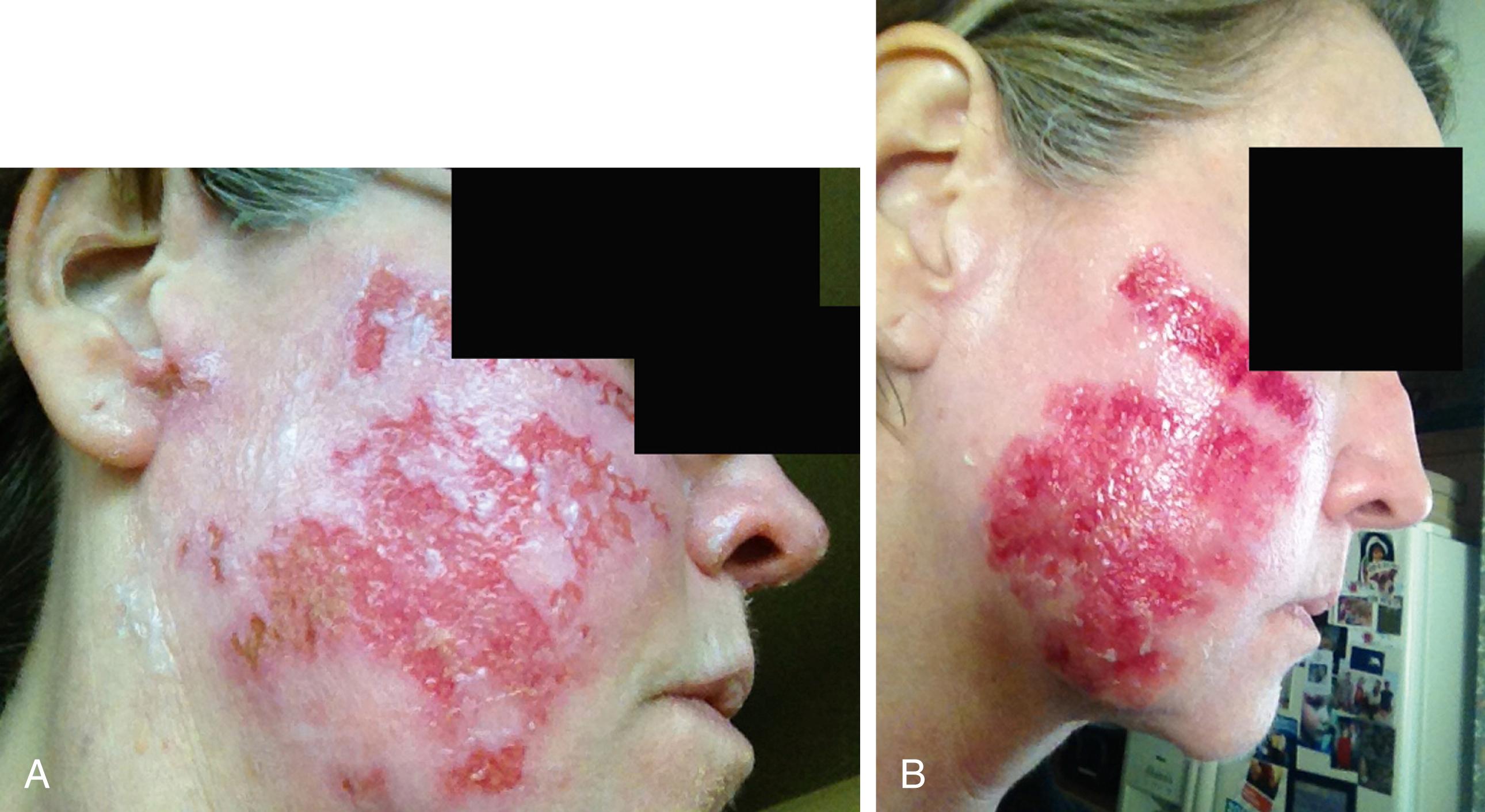Physical Address
304 North Cardinal St.
Dorchester Center, MA 02124
Considering that skin resurfacing is, for the most part, an elective procedure, the tolerance for complications is very low on the part of the patient. For the physician, resurfacing the skin involves creating a controlled injury to the skin surface followed by the natural healing process of the skin. The recovery period for a medium-depth to deep peel can range from 7 to 14 days. Any adverse event during the healing process can push this time out even further and may take a large emotional toll on the patient. Unlike other cosmetic procedures where the healing process is hidden under the skin surface, during skin resurfacing, the healing process is visible to the patient, family, and the physician. Thus any complication is also highly visible and disturbing to the patient.
One must remember that the role of skin is to serve as a physiological barrier to prevent fluid loss and to protect the human body from exposure to trauma, ultraviolet radiation, infections, and toxins . Other major functions of the skin include sensory perception, immune recognition, and thermoregulation. The skin is composed of two layers, epidermis and dermis, that overlie the subcutaneous fat. The epidermis is about 50 μm in thickness and consists of three major resident cells, keratinocytes, Langerhans cells, and melanocytes. The main substance of the dermis contains collagen, elastin, and glycosaminoglycans along with vascular structures and nerve endings and provides circulation, nutrition, and structural support for the epidermis. Fibroblasts, macrophages, and dendritic cells are the main resident cells in the dermis. Fibroblasts produce the collagen, elastin, and glycosaminoglycans that constitute the dermal matrix. Adnexal structures include eccrine glands, apocrine glands, sebaceous glands, and hair follicles. It is these adnexal structures that help to reepithelialize the skin after skin resurfacing.
Early recognition and management of complications is key. Regardless of the type of resurfacing modality, whether peels or lasers, many of the post-resurfacing complications are the same ( Table 16.1 ).
| Temporary Complication | Potentially Permanent Complications |
|---|---|
| Swelling | Persistent erythema |
| Contact dermatitis | Scarring |
| Infection (viral, bacterial, fungal) | Texture change |
| Milia | Hypopigmentation |
| Acne flare/rosacea flare | Lines of demarcation |
| Postinflammatory hyperpigmentation | |
| Ocular injury |
Skin-resurfacing procedures that generate a lot of heat or that penetrate to the papillary dermis or reticular dermis level will result in a variable amount of swelling that differs among patients. Typically, swelling begins the night of or the day after the procedure, peaks at 48 hours, and then begins to resolve starting at 72 hours ( Fig. 16.1 ). Management of swelling is by having the patient apply “crushed-ice” bags or frozen peas in small plastic bags to the cheeks and periorbital areas 10 minutes an hour for the first 48 hours. Sleeping with the head elevated to at least 45 degrees helps reduce swelling. Finally, if swelling is severe and the patient’s eyes are swollen almost shut, an oral steroid taper can be given as long as the patient has no contraindications to systemic steroid therapy.

Contact dermatitis, usually irritant in nature, is commonly seen after skin resurfacing because of an impaired epidermal barrier function. Patch testing is not generally helpful during the postoperative period, because time is of the essence in managing this issue. However, once healed, patch testing can be performed if desired. However, the dermatitis is rarely a true type IV delayed hypersensitivity reaction, because patch testing fails to reveal the allergens in most cases.
Presenting symptoms are often new-onset burning and itching of the skin along with increased redness. Healing regression and eczematous eruptions may also occur ( Fig. 16.2 ). Patients can develop contact dermatitis at any time during the postoperative period. The denuded or deepithelialized skin allows for ingredients to easily penetrate through the skin, thus making the skin more susceptible to topical irritants such as fragrances, propylene glycol, lanolin, and allergens in cleansers, moisturizes, and topical ointments. Patients should be instructed to adhere strictly to the postoperative products given to them to avoid self-prescribed topical “herbal” regimens or topical antibiotics (such as Neosporin [Johnson & Johnson, New Brunswick, NJ] or bacitracin) during the healing process.

If contact dermatitis is suspected, the patient should be instructed to stop all topical lotions and cleansers. Instead, the patient should wash the skin twice a day with plain water and apply a bland petrolatum ointment two to three times a day until healed. If the reaction is severe or the patient is very uncomfortable, a mid-potency topical steroid and oral antihistamines are helpful to alleviate pruritus and the cutaneous eruptions. If the patient has significant skin weeping, topical gauze dilute vinegar compresses (1 teaspoon white vinegar in 2 cups of water) can be applied for 5 to 10 minutes per hour. In severe cases, systemic steroids may be warranted to decrease the risks of postinflammatory hyperpigmentation (PIH) and scarring.
Denuded skin is a prime site for infection, because the skin barrier function is impaired. Early recognition and management of skin infections will help mitigate the risk of scarring. Postoperative infections can be yeast, viral, or bacterial. The timing of the onset of symptoms can be helpful ( Table 16.2 ).
| Infectious Agent | Onset | Diagnosis |
|---|---|---|
| Bacteria | Any time after 24 hours | Gram stain Culture and sensitivities Empiric coverage until culture and sensitivity results are in Adjust antibiotic if needed |
| Virus | Usually after 48 hours but can occur at any time until skin is fully reepithelialized up to postoperative days 7–14 | Tzank prep PCR, DIF, or DFA Viral culture |
| Yeast | Usually after day 5 | KOH prep |
Rapid onset of discomfort, pruritic papules and pustules, focal areas of increased erythema, purulence, malodorous discharge, and crusting are signs of bacterial infection. Staphylococcus aureus ( Fig. 16.3A ) is the most commonly isolated species, but even Pseudomonas aeruginosa and Serratia marcescens ( Fig. 16.3B ) can occur. S. marcescens is a gram-negative anaerobic bacillus belonging to the Enterobacteriaceae family. However, if the wound is occluded for more than 48 hours or if prophylactic antibiotics are used, the incidence of a gram-negative infection, including P. aeruginosa, is significantly increased.

Any patient suspected to have an infection should have skin swabs sent for Gram stain as well as culture and sensitivity. An antibiotic can be prescribed to treat the suspected infection and then modified once the sensitivities are available. In the author’s practice, bacterial skin infection post-resurfacing is almost nonexistent once patients were instructed to apply mupirocin ointment to the nares of the nose three times a day starting 1 week before their procedure and for 1 to 2 weeks afterward (until fully healed).
Minimizing the risk of infection is key. Therefore meticulous wound care with decreased duration of occlusion, frequent dressing changes, and thorough cleaning of the wound with 0.25% acetic acid solution are effective in reducing the bacterial colonization. The routine use of prophylactic antibiotics is controversial, although it is recommended in patients with increased risks of infections.
A flare of herpes simplex virus (HSV) or an eruption of varicella zoster virus (VZV) during the recovery period can be disastrous. It is critical to recognize and treat the infection to prevent delayed wound healing, disseminated viral infection, secondary bacterial infection with S. aureus , and, most importantly, scarring. The nature of the infection with VZV and HSV viruses results in deep erosions that can heal with extensive scarring. Because the skin is deepithelialized, viral infection may only present as superficial erosions that spread and enlarge, as opposed to the classic vesiculopustules that appear on normal skin ( Fig. 16.4A–B ). Typically, the patient presents with new-onset healing regression and rapidly spreading erosions that do not necessarily start on the lips. These erosions are accompanied by pain and discomfort. Touching them and then touching other areas of open skin can transmit the virus to that region. Prior HSV infections can be subclinical; therefore all patients who plan to undergo full-face or perioral resurfacing should receive oral antiviral prophylaxis such as acyclovir, famciclovir, or valacyclovir. The prophylaxis should be initiated 1 to 2 days before the resurfacing and continued for 7 days (medium-depth peels or light laser resurfacing) to 15 days (dermabrasion, laser resurfacing, and deep peels) until reepithelialization of the skin is complete.

However, despite appropriate prophylactic antiviral therapy, some patients can still experience an outbreak while on a suppressive regimen. If an HSV or VZV infection is suspected, a viral culture or a swab for polymerase chain reaction (PCR) for VZV and HSV should be sent as soon as possible, and the dosing of antiviral therapy should be increased to the dose used to treat a zoster infection (i.e., valacyclovir 1000 mg three times a day for 10 days). Viral infections can sometimes yield a false negative if the lesion that is cultured is older than 48 hours. Therefore, even if the viral culture or PCR are negative, the course of antiviral therapy should be continued. I believe strongly that many viral infections are reactivated VZV rather than disseminated HSV. Both can then spread quickly to denuded areas; thus they may not appear as a typical viral infection would.
Become a Clinical Tree membership for Full access and enjoy Unlimited articles
If you are a member. Log in here